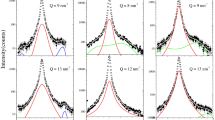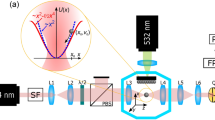Abstract
Studies of acoustic vibrations in nanometre-scale particles can provide fundamental insights into the mechanical properties of materials because it is possible to precisely characterize and control the crystallinity and geometry of such nanostructures1,2,3,4. Metal nanoparticles are of particular interest because they allow the use of ultrafast laser pulses to generate and probe high-frequency acoustic vibrations, which have the potential to be used in a variety of sensing applications. So far, the decay of these vibrations has been dominated by dephasing due to variations in nanoparticle size5. Such inhomogeneities can be eliminated by performing measurements on single nanoparticles deposited on a substrate6,7,8,9, but unknown interactions between the nanoparticles and the substrate make it difficult to interpret the results of such experiments. Here, we show that the effects of inhomogeneous damping can be reduced by using bipyramidal gold nanoparticles with highly uniform sizes10. The inferred homogeneous damping is due to the combination of damping intrinsic to the nanoparticles and the surrounding solvent; the latter is quantitatively described by a parameter-free model.
This is a preview of subscription content, access via your institution
Access options
Subscribe to this journal
Receive 12 print issues and online access
$259.00 per year
only $21.58 per issue
Buy this article
- Purchase on Springer Link
- Instant access to full article PDF
Prices may be subject to local taxes which are calculated during checkout



Similar content being viewed by others
References
Hartland, G. V. Measurements of the material properties of metal nanoparticles by time-resolved spectroscopy. Phys. Chem. Chem. Phys. 6, 5263–5274 (2004).
Tang, Y. & Ouyang, M. Tailoring properties and functionalities of metal nanoparticles through crystallinity engineering. Nature Mater. 6, 754–759 (2007).
Still, T. et al. The ‘music’ of core–shell spheres and hollow capsules: influence of the architecture on the mechanical properties at the nanoscale. Nano Lett. 8, 3194–3199 (2008).
Portales, H. et al. Probing atomic ordering and multiple twinning in metal nanocrystals through their vibrations. Proc. Natl Acad. Sci. USA 105, 14784–14789 (2008).
Hartland, G. V. Coherent excitation of vibrational modes in metallic nanoparticles. Annu. Rev. Phys. Chem. 57, 403–430 (2006).
van Dijk, M. A., Lippitz, M. & Orrit, M. Detection of acoustic oscillations of single gold nanospheres by time-resolved interferometry. Phys. Rev. Lett. 95, 267406 (2005).
Staleva, H. & Hartland, G. V. Transient absorption studies of single silver nanocubes. J. Phys. Chem. C 112, 7535–7539 (2005).
Staleva, H. & Hartland, G. V. Vibrational dynamics of silver nanocubes and nanowires studied by single-particle transient absorption spectroscopy. Adv. Func. Mater. 18, 3809–3817 (2008).
Zijlstra, P., Tchebotareva, A., Chon, J., Gu, M. & Orrit, M. Acoustic oscillations and elastic moduli of single gold nanorods. Nano Lett. 8, 3493–3497 (2008).
Liu, M. Z. & Guyot-Sionnest, P. Mechanism of silver(I)-assisted growth of gold nanorods and bipyramids. J. Phys. Chem. B 109, 22192–22200 (2005).
Yang, Y. T., Callegari, C., Feng, X. L., Ekinci, K. L. & Roukes, M. L. Zeptogram-scale nanomechanical mass sensing. Nano Lett. 6, 583–586 (2006).
Bunch, J. S. et al. Electromechanical resonators from graphene sheets. Science 315, 490–493 (2007).
Jensen, K., Kim, K. & Zettl, A. An atomic-resolution nanomechanical mass sensor. Nature Nanotech. 3, 533–537 (2008).
Burg, T. P. et al. Weighing of biomolecules, single cells and single nanoparticles in fluid. Nature 446, 1066–1069 (2007).
Del Fatti, N., Voisin, C., Christofilos, D., Vallée, F. & Flytzanis, C. Acoustic vibration of metal films and nanoparticles. J. Phys. Chem. A 104, 4321–4326 (2000).
Pelton, M., Aizpurua, J. & Bryant, G .W. Metal–nanoparticle plasmonics. Laser Photon. Rev. 2, 135–169 (2008).
Hartland, G. V. Coherent vibrational motion in metal particles: determination of the vibrational amplitude and excitation mechanism. J. Chem. Phys. 116, 8048–8055 (2002).
Sader, J. E. Frequency response of cantilever beams immersed in viscous fluids with applications to the atomic force microscope. J. Appl. Phys. 84, 64–76 (1998).
Saviot, L., Netting, C. & Murray, D. Damping by bulk and shear viscosity of confined acoustic phonons for nanostructures in aqueous solution. J. Phys. Chem. B 111, 7457–7461 (2007).
Nowick, A. S. & Berry, B. S. Anelastic Relaxation in Crystalline Solids (Academic Press, 1972).
Acknowledgements
Work at the Center for Nanoscale Materials was supported by the US Department of Energy (contract no. DE-AC02-06CH11357). J.B. was fully supported and M.Z.L. was partially supported by the US National Science Foundation (grant no. CHE-0718718). J.E.S. acknowledges support from the Australian Research Council Grants Scheme.
Author information
Authors and Affiliations
Contributions
M.P. designed the research project, carried out the transient-absorption measurements, analysed the data and wrote the paper. J.E.S. developed the analytical model for fluid damping of nanoparticle vibrations and analysed the experimental results. J.B. carried out the finite-element modelling and contributed to data analysis. M.L. and J.B. synthesized the gold bipyramids and prepared the samples. P.G.S. contributed to project design and the understanding of the experimental results, and D.G. contributed to the transient-absorption measurement capabilities. All authors discussed the results and contributed to writing of the manuscript.
Corresponding author
Supplementary information
Supplementary information
Supplementary information (PDF 696 kb)
Rights and permissions
About this article
Cite this article
Pelton, M., Sader, J., Burgin, J. et al. Damping of acoustic vibrations in gold nanoparticles. Nature Nanotech 4, 492–495 (2009). https://doi.org/10.1038/nnano.2009.192
Received:
Accepted:
Published:
Issue Date:
DOI: https://doi.org/10.1038/nnano.2009.192
This article is cited by
-
Single-particle photoacoustic vibrational spectroscopy using optical microresonators
Nature Photonics (2023)
-
Analytical approach for predicting vibration characteristics of an embedded elastic sphere in complex fluid
Archive of Applied Mechanics (2020)
-
Super-resolution imaging using nano-bells
Scientific Reports (2018)
-
Direct observation of polymer surface mobility via nanoparticle vibrations
Nature Communications (2018)
-
Bragg Coherent Diffractive Imaging of Zinc Oxide Acoustic Phonons at Picosecond Timescales
Scientific Reports (2017)



